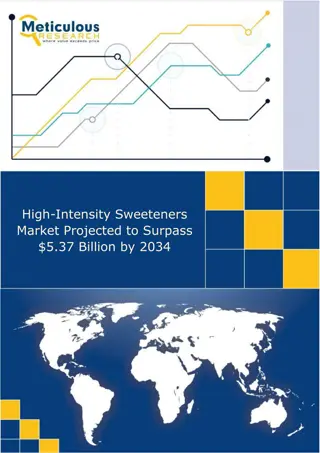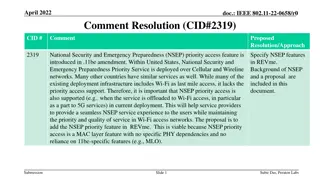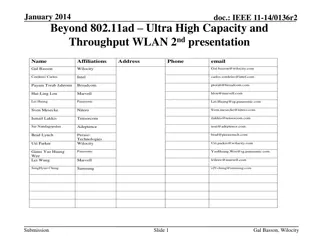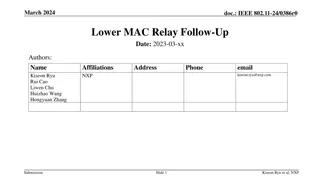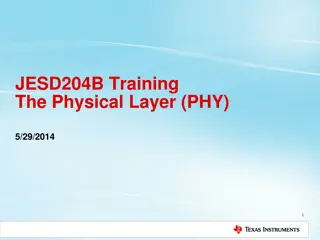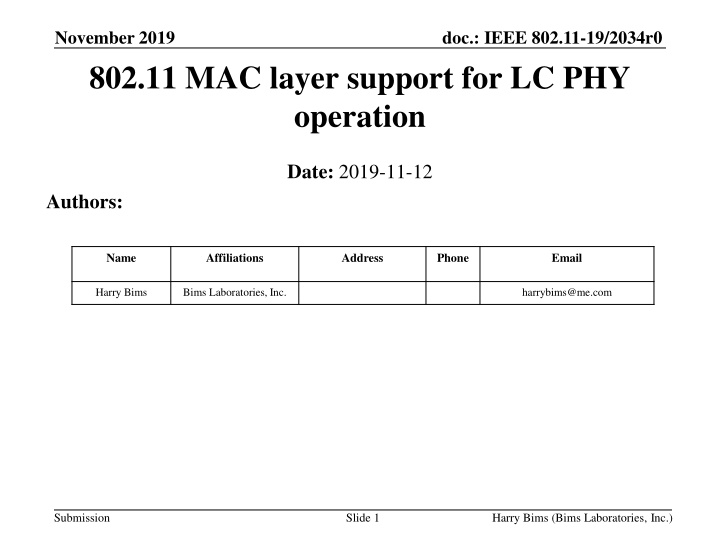
IEEE 802.11-19/2034r0 MAC Layer Support for LC PHY Operation
This document discusses the scope of MAC layer changes within IEEE 802.11 standard to support LC PHY operation, focusing on features like Hybrid Coordination Function, OBSS detection, and power management modes. It compares two MAC/PHY combinations and highlights the need to limit unnecessary features for efficient operation.
Download Presentation

Please find below an Image/Link to download the presentation.
The content on the website is provided AS IS for your information and personal use only. It may not be sold, licensed, or shared on other websites without obtaining consent from the author. If you encounter any issues during the download, it is possible that the publisher has removed the file from their server.
You are allowed to download the files provided on this website for personal or commercial use, subject to the condition that they are used lawfully. All files are the property of their respective owners.
The content on the website is provided AS IS for your information and personal use only. It may not be sold, licensed, or shared on other websites without obtaining consent from the author.
E N D
Presentation Transcript
doc.: IEEE 802.11-19/2034r0 November 2019 802.11 MAC layer support for LC PHY operation Date: 2019-11-12 Authors: Name Affiliations Address Phone Email Harry Bims Bims Laboratories, Inc. harrybims@me.com Submission Slide 1 Harry Bims (Bims Laboratories, Inc.)
doc.: IEEE 802.11-19/2034r0 November 2019 Abstract Scope of 802.11 MAC layer changes that support the LC PHY is limited by the LC PAR This amendment specifies changes to the IEEE 802.11 MAC that are limited to the following: 1) Hybrid coordination function (HCF) channel access, 2) Overlapping basic service set (OBSS) detection and coexistence, 3) Existing power management modes of operation (excluding new modes), and modifications to other clauses necessary to support these changes. We need to clarify the scope of MAC changes includes: Changing/adding 802.11 MAC features that affect the LC PHY Limiting the optional modes of the 802.11 MAC Submission Slide 2 Harry Bims (Bims Laboratories, Inc.)
doc.: IEEE 802.11-19/2034r0 November 2019 Motivation (1) TGbb has been discussing two MAC/PHY combinations (AX approach): 802.11ax MAC + 802.11ax PHY (PHY change necessary to support LC PHY) (G.hn approach): 802.11 ?? MAC + G.hn PHY (requires more extensive MAC changes) Both approaches have flaws and advantages And both can be supported in the LC MAC layer Submission Harry Bims (Bims Laboratories, Inc.) Slide 3
doc.: IEEE 802.11-19/2034r0 November 2019 Motivation (2) However, both approaches will allow many 802.11 MAC features that are not necessary Some are optional, some are mandatory Can limit unnecessary mandatory features by limiting the MAC to the appropriate 802.11 MAC amendment Can limit unnecessary optional features through management layer configuration G.hn approach will not work without modifying the 802.11 MAC Submission Harry Bims (Bims Laboratories, Inc.) Slide 4
doc.: IEEE 802.11-19/2034r0 November 2019 Comparison of LC MAC mode Frameworks Option 1 Option 2 MAC/PHY layers MAC/PHY layers 802.11ax MAC 802.11 ?? MAC ?? PHY SAP ?? MLME-PLME SAP ?? PLME SAP ?? Message formats PHY SAP MLME-PLME SAP PLME SAP Message formats Existing Changed G.hn PHY 802.11ax PHY Submission Slide 5 Harry Bims (Bims Laboratories, Inc.)
doc.: IEEE 802.11-19/2034r0 November 2019 Example MAC amendments for consideration 802.11n Minimal features to support high throughput 802.11ac Enhanced features to support very high throughput 802.11ax Maximum features that support future throughput needs Submission Harry Bims (Bims Laboratories, Inc.) Slide 6
doc.: IEEE 802.11-19/2034r0 November 2019 802.11n (1) The IEEE 802.11 HT STA provides physical layer (PHY) and medium access control (MAC) features that can support a throughput of 100 Mb/s and greater, as measured at the MAC data service access point (SAP). Some PHY features that distinguish an HT STA from a non-HT STA are referred to as multiple input, multiple output (MIMO) operation; spatial multiplexing (SM); spatial mapping (including transmit beamforming); space-time block coding (STBC); low-density parity check (LDPC) encoding; and antenna selection (ASEL). Submission Slide 7 Harry Bims (Bims Laboratories, Inc.)
doc.: IEEE 802.11-19/2034r0 November 2019 802.11n (2) An HT STA has MAC features that include frame aggregation, some Block Ack features, power save multi- poll (PSMP) operation, reverse direction (RD), and protection mechanisms supporting coexistence with non-HT STAs. Submission Slide 8 Harry Bims (Bims Laboratories, Inc.)
doc.: IEEE 802.11-19/2034r0 November 2019 802.11ac STAs (1) The IEEE 802.11 VHT STA operates in frequency bands below 6 GHz excluding the 2.4 GHz band. A VHT STA is an HT STA that, in addition to features supported as an HT STA, supports VHT features identified in Clause 8, Clause 9, Clause 10, Clause 13, Clause 18, and Clause 22. Submission Slide 9 Harry Bims (Bims Laboratories, Inc.)
doc.: IEEE 802.11-19/2034r0 November 2019 802.11ac (2) The main PHY features in a VHT STA that are not present in an HT STA are the following: Mandatory support for 40 MHz and 80 MHz channel widths Mandatory support for VHT single-user (SU) PPDUs Optional support for 160 MHz and 80+80 MHz channel widths Optional support for VHT sounding protocol to support beamforming Optional support for VHT multi-user (MU) PPDUs Optional support for VHT-MCSs 8 and 9 Submission Slide 10 Harry Bims (Bims Laboratories, Inc.)
doc.: IEEE 802.11-19/2034r0 November 2019 802.11ac (3) The main MAC features in a VHT STA that are not present in an HT STA are the following: Mandatory support for the A-MPDU padding of a VHT PPDU Mandatory support for VHT single MPDU Mandatory support for responding to a bandwidth indication in a non-HT and non-HT duplicate RTS frame Optional support for MPDUs of up to 11 454 octets Optional support for A-MPDU pre-end-of-frame (pre-EOF) padding (see 9.12.2 (A-MPDU length limit rules)) of up to 1 048 575 octets Optional support for VHT link adaptation Submission Slide 11 Harry Bims (Bims Laboratories, Inc.)
doc.: IEEE 802.11-19/2034r0 November 2019 802.11ac (4) Most VHT features, among other benefits, increase the maximum throughput achievable between two VHT STAs over that achievable using HT features alone. The VHT features are available to VHT STAs associated with a VHT AP in a BSS. The support for VHT transmit beamforming sounding and VHT MU PPDUs in a VHT AP and more than one VHT STA within a VHT BSS enables the optional use of downlink MU multiple input, multiple output (DL-MU-MIMO). The use of certain HT features, such as RIFS, is not permitted for STAs operating as VHT STAs. Submission Slide 12 Harry Bims (Bims Laboratories, Inc.)
doc.: IEEE 802.11-19/2034r0 November 2019 802.11ac (5) With DL-MU-MIMO the AP can create up to four A-MPDUs, each carrying MPDUs destined for an associated MU-capable STA. The AP uses group identifiers (GIDs) to signal potential recipient STAs. The AP transmits the A-MPDUs simultaneously in separate space- time streams such that each recipient STA is able to demodulate the space-time streams carrying its A-MPDU. The simultaneous transmission of A-MPDUs in a single VHT MU PPDU provides a means to increase aggregate throughput over that achieved by sending the A-MPDUs in separate SU PPDUs. The use of certain HT features, such as RIFS, is not permitted for STAs operating as VHT STAs. Submission Slide 13 Harry Bims (Bims Laboratories, Inc.)
doc.: IEEE 802.11-19/2034r0 November 2019 802.11ax (1) The IEEE 802.11 HE STA operates in frequency bands between 1 GHz and 7.125 GHz. The main PHY features in an HE STA that are not present in VHT STA or HT STA are the following: Mandatory support for DL MU-MIMO by an HE AP that supports 4 or more spatial streams MU-MIMO is done on the entire PPDU bandwidth Mandatory support for DL MU-MIMO reception for a non-AP HE STA Mandatory support for the HE sounding protocol to support beamforming Optional support for HE-MCSs 10 and 11 Optional support for UL MU-MIMO Optional support for preamble puncturing Submission Slide 14 Harry Bims (Bims Laboratories, Inc.)
doc.: IEEE 802.11-19/2034r0 November 2019 802.11ax (2) The main MAC features in an HE STA that are not present in VHT STA or HT STA are the following: In an AP, mandatory support for the role of operating mode indication (OMI) responder and optional support for the role of OMI initiator In a non-AP STA, optional support for the roles of OMI initiator and responder In an AP, optional support for two NAV operation In a non-AP STA, mandatory support for two NAV operation In an AP, mandatory support for individual target wake time (TWT) operation In a non-AP STA, optional support for individual TWT operation Optional support for broadcast TWT Optional support for UL OFDMA-based random access (UORA) Optional support for spatial reuse operation Optional support for multi-TID A-MPDU operation Optional support for ER BSS Mandatory support for multiple BSSID operation in a non-AP STA Optional support for the NDP feedback report Submission Slide 15 Harry Bims (Bims Laboratories, Inc.)
doc.: IEEE 802.11-19/2034r0 November 2019 802.11ax (3) These features can reduce protocol overhead and increase aggregate network throughput (e.g., DL and UL OFDMA, DL/UL MU-MIMO), enhance peak link throughput (e.g., MCS 10, 11), enhance dense network efficiency (e.g., spatial reuse), and/or enhance power conservation (e.g., TWT). These features can, under certain circumstances, improve the average throughput per STA in a BSS by a factor of four, compared to VHT. Submission Slide 16 Harry Bims (Bims Laboratories, Inc.)
doc.: IEEE 802.11-19/2034r0 November 2019 Conclusion It is within the scope of the LC MAC to support both an 802.11ax PHY and a G.hn PHY A two mode MAC implementation can resolve the PHY discussions We should focus MAC proposals to 802.11ax, 802.11ac, and 802.11n amendments as candidate starting points Recommend 802.11ac for G.hn PHY reduced complexity while keeping enhanced features of VHT However, a clarification of the MAC scope is necessary: To allow changes so the MAC can properly interface to the LC PHY To allow MAC proposals that address the need to simplify the MAC implementation Submission Slide 17 Harry Bims (Bims Laboratories, Inc.)


![Global Medical Robots Market Research Analysis & Forecast [2024-2034]](/thumb/86013/global-medical-robots-market-research-analysis-forecast-2024-2034.jpg)

